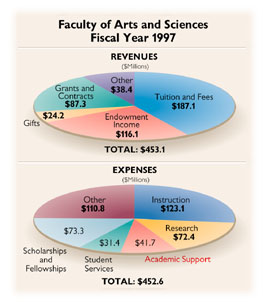![]()
Main Menu · Search · Current Issue · Contact · Archives · Centennial · Letters to the Editor · FAQs
![]()
Main Menu · Search · Current Issue · Contact · Archives · Centennial · Letters to the Editor · FAQs

Having balanced the budget of the Faculty of Arts and Sciences after six years of effort, one would expect Jeremy R. Knowles, dean, to put his feet up for a moment. But in his annual letter to colleagues, discussed in a February faculty meeting, the dean figuratively paces his office, contemplating new worries.
Despite increased payouts from the endowment, and the progress of the University Campaign (as of February 28, FAS had raised $813 million, or 84 percent of its goal), Knowles draws attention to Harvard's crumbling libraries and needed technology investments there--daunting new demands on available resources (see Cooked Books: Costly Rx for Libraries and Digital Union of Images Will Break Boundaries). He highlights increased public scrutiny of the cost of undergraduate education. That implies pressure on tuition, the source of more than 40 percent of FAS revenues (excluding research grants), and more than 60 percent of unrestricted funds. The scrutiny has only intensified since Knowles composed his letter, as other schools have increased financial aid (see Faster Track on Financial Aid).
His other concerns involve FAS's human resources and the changing sources of support for research.
Turning first to the graduate school, Knowles observes that Harvard attracts "outstanding students" and that the rate of acceptances among applicants to whom Harvard offers admission is "the highest in the country." But he notes that Harvard's offers "provide only two years of guaranteed support," and are "becoming less competitive in many fields." So, FAS must "with some urgency" revisit its graduate-student aid formula, a task in which it will be aided by the recommendations forthcoming from a committee chaired by Peter Ellison, Ph.D. '83, professor of anthropology.
On the matter of compensation, Knowles notes that "our senior faculty have received, on average, the highest...salaries for Faculties of Arts and Sciences in the country." Nevertheless, that average conceals the fact that "the spread of senior faculty salaries at Harvard is comparatively small." This makes it more difficult to attract or retain professors when "peer institutions are moving towards a de facto 'star system,' where a few receive high salaries and many others are much more modestly compensated." The pressure is particularly intense, he says, "where we face competition from professional schools and research institutes." Acknowledging the appeal of professing at Harvard--the quality of colleagues and of students,
the libraries and research facilities--Knowles nonetheless warns of problems emerging when "we could all earn more elsewhere as the lone star in a less luminous firmament."
Nor, apparently, is the excellence of those scientific research facilities assured. Given constraints on federal funding (see "Fiscal Fitness," March-April, page 62), universities increasingly must offer seed money, matching funds, and common facilities--what Knowles, a chemist, called "support for such essential services as homes for mice, sophisticated analytical instrumentation, and massive computing facilities." "The landscape has changed," he writes, so it is not certain that Harvard provides "the support that is increasingly available elsewhere."
The dean's letter does not put a price tag on solving these problems. Rather, he intends "to remind us that we shall continue to face difficult choices among competing priorities. We shall not be able simultaneously to lower tuition increases, to make the most competitive offers to graduate students, to reduce section size, to improve faculty salaries, and to add to the ranks of the faculty."
In one of his happier passages, Knowles notes that the last of these goals is receiving priority. The University Campaign set the ambitious target of creating 40 new FAS faculty positions, targeting "those areas where the undergraduate teaching need is greatest," including concentrations with the highest ratio of students to professors, and Core classes. Core offerings will expand as the quantitative reasoning requirement phases in. Although much of the funding sought remains to be raised, the dean is authorizing, in one of the "first fruits" of the Campaign, the creation of a dozen new faculty positions. Departments invited to create the new positions--the first since 1990--are anthropology, chemistry, molecular and cellular biology, the division of applied sciences, economics, government, fine arts, music, philosophy, physics, psychology, and statistics. This is a step that the dean expresses hope of being able to repeat "in a measured way" in the years to come.
Main Menu · Search · Current Issue · Contact · Archives · Centennial · Letters to the Editor · FAQs
![]()